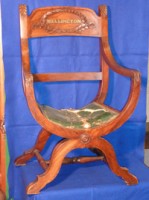Discovered during a routine valuation morning at the Chipping Norton branch of Tayler and Fletcher, Auctioneer and Valuer Stephen Sheppard could not believe his eyes when a photograph of The Duke of Wellington Chair appeared before him.
Field Marshal Arthur Wellesley, 1st Duke of Wellington, KG, GCB, GCH, PC, FRS (1 May 1769 – 14 September 1852), was a British soldier and statesman, a native of Ireland, from the Anglo-Irish Ascendancy and one of the leading military and political figures of the nineteenth century. He is often referred to as the ‘Duke of Wellington,’ even after his death and there have been subsequent Dukes of Wellington.
Wellington rose to prominence as a general during the Peninsular campaign of the Napoleonic Wars, and was promoted to the rank of field marshal after leading the allied forces to victory against the French at the Battle of Victorian in 1813. Following Napoleon’s exile in 1814, he served as the ambassador to France and was granted a dukedom. During the Hundred Days war in 1815, he commanded the allied army which, with a Prussian army under Blücher, defeated Napoleon at the Battle of Waterloo. Wellesley’s battle record is exemplary, ultimately participating in some 60 battles throughout his military career; he was also twice prime minister under the Tory party and remained Commander-in-Chief of the British Army until his death.
Following further research, it was discovered that The Gentleman’s Magazine of 1836 carried a contemporary review of Dykes Tour in Belgium – Kay’s Caffraria, which states “As to accuracy of fact – Mr Dyke mentions that the elm tree on the plain of Waterloo, under which Lord Wellington stood, “was purchased of a farmer, by a mercenary Goth from England, who hacked and twisted it into tooth picks and snuff boxes”. Now the fact is, that this said mercenary Goth was John George Children, Esq. of the British Museum, the learned and scientific translator of Berzelius, who did not cut it into tooth picks or snuff boxes, but formed it into a massive and handsome chair, in which he reposes, and which he does not sell.” Could this be the very chair mentioned in the magazine article of 1836? The Wellington Chair is estimated at £5,000-£8,000 and measures 97cm high x 61cm wide. Provenance: Purchased at a country house sale in Oxfordshire during the 1950’s thence by descent to the private vendor.
This fine piece of furniture is only one small part of a much larger auction sale that will include ceramics, glassware, metalware and bronzes, silverware, jewellery, clocks watches and barometers, collectables and bijouterie, paintings and pictures, mirrors and books, soft furnishings, textiles and hand knotted oriental rugs and carpets and viewing for this particular auction sale at the Pittville Pump Room, Cheltenham, is on Wednesday the 29th February from 8am-7pm and also on the morning of the sale from 7.30am until the start of sale at 10am. 01451 821666 www.taylerandfletcher.co.uk

Oh wow! What an amazing find. Now we all know what a couple of ladies want for Christmas, don't we??
Hello Vicky. More on this in my blog – http://battlefield-tours.blogspot.com
Goes up for sale today. It would be interesting to see for how much!